CrossFit is a lot of things, but it is not predictable. The nature of CrossFit programming is precisely that it’s hard to pin down. You’re never supposed to know what any given WOD — that’s CrossFit-speak for workout of the day — is going to emphasize.
Your WOD may focus on explosive barbell strength, endurance, gymnastics movements, all of the above, or something else entirely. That doesn’t mean that you can never focus on anything during your CrossFit training. If you want to be able to generate more power and speed — get faster and stronger under the bar — you can certainly use CrossFit to get there.

Here, you’ll learn how to design CrossFit workouts for speed and power. You can swap these workouts for other, less specific WODs, or give yourself a nice two-a-day treat. Either way, you’ll become more explosive, faster, and much stronger.
- What Are Speed and Power in Strength Training?
- How to Increase Speed and Power in CrossFit
- How to Design CrossFit Workouts for Speed and Power
- Sample CrossFit Workout for Speed and Power
- Your Takeaways
What Are Speed and Power in Strength Training?
First things first: power is not strength. Power in the weight room has a very specific meaning. Power combines load and time, while strength is simply about the load.
In the context of force production, muscular power is how much force you can generate in a specific amount of time. Strength, on the other hand, is only about how much weight you can lift — no matter how long you grind.
And while there’s not necessarily anything wrong with the grind, power refers to how much you can lift and how fast you can lift it. Because power introduces the element of time to the idea of strength, speed is what connects strength and power.
In summary:
- Strength: how much weight you can lift
- Power: how much weight you can lift in a given amount of time
- Speed: how fast you can move weight; the connection between strength and power.
These definitions might help you think more critically about certain misnomers in the weight room. Take powerlifting. Despite the misleading name, even the strongest powerlifters may not be that powerful.
[Read More: The Best Leg Exercises for Your Next Leg Day]
For example: you might be able to deadlift three plates without breaking too much of a sweat. But if someone asks you to clean those 315 pounds to your shoulders — which requires a lot of speed and therefore, power — you might give up before you get started. That’s not because you’re not strong. You might just have to work to develop a lot more power.
To achieve that level of power, you don’t just need to get faster. You need to get faster under a heavy load. Will you be fast if you can perform a bunch of box jumps quickly? Yes. And your legs will get a lot more powerful doing box jumps than regular air squats.
But if you want to develop power with heavy weightlifting moves, you’ll need to get speedier under a loaded barbell. Combining these skill sets to make you stronger and faster — i.e., more powerful — is the task these CrossFit workout designs will help you accomplish.
How to Increase Speed and Power in CrossFit
Since many CrossFit WODs are designed to get you jumping or explosively sending barbells over your head, speed and power are often at the forefront of your priorities. Speed is often a critical factor in CrossFit, as so many workouts are performed “for time.”
The best time wins. So, there’s quite a need for speed. Here’s how to get it.
Lighten the Load — Sometimes
The Rx in CrossFit refers to doing a workout “as prescribed.” When you’re doing an Rx workout, you’ll use the weights and rep schemes given in the workout as written. But if you’re finding that using the Rx weights are dragging your movements to a grinding pace, consider lightening the load.
When you’re using less weight, you’ll be better able to focus on form — which is key to both injury-prevention and being able to efficiently move the barbell. Working with lighter weights may boost your power output. (1) Think about how much faster that barbell feels when you strip off those extra 10s or 25s.
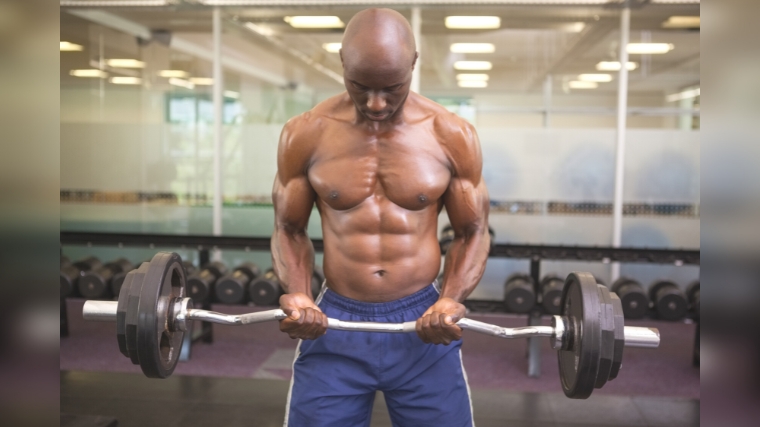
That said, you don’t want to only work with light weight. Power is not just about speed — you also want to increase the amount of weight you can move quickly. Research suggests that combining light speed work with heavier sets is an optimal way to improve power output. (1)(2)
Add Plyometrics
If you’re a CrossFitter, your training sessions — and your nightmares — are likely already full of tough plyometric movements. Think burpees, box jumps, and burpee box jumps. When you’re training for power and speed, don’t neglect these moves. Instead, bring them out in full force.
Integrate explosive bodyweight movements into your WODs if they’re not there already. Alternatively, use these moves as finishers to help give your power and speed the boosts you’re looking for.
Just make sure you’re maintaining the rest of your resistance training like heavy barbell work. Plyometric training seems most effective at improving lower body power when you integrate it into a lifting program. (3)
Don’t Skimp on Olympic Lifting
It’s not a coincidence that some of the most elite CrossFitters — Tia-Clair Toomey and Mat Fraser come to mind — are extremely skilled, experienced, and successful Olympic lifters. Weightlifting is a huge part of many CrossFit WODs.
Even if you’re new to Olympic lifting, getting your hands dirty with snatches and clean & jerks will be a key part of your CrossFit journey. Focus first and foremost on your technique. As you continue your barbell training, you’ll reap the benefits of increased speed and power from mastering Olympic lifts. (4)
Focus on Speed
This one might seem obvious, but it also sometimes seems futile. You may enter the “pain cave” — that part of a CrossFit WOD where everything burns and pressing on seems all but impossible. When you’re there, your body may slow down quite a lot. But that doesn’t necessarily mean you won’t get faster.
Research suggests that attempting to move faster can be just as helpful as actually achieving a quick pace. (5) The intention and effort of trying to move at full force can help train your body to keep pushing those limits. This means that even if you’re the slowest in your CrossFit class, you are likely still getting faster.
As long as you’ve got solid form, if you’re pushing, you’re probably improving.
How to Design CrossFit Workouts for Speed and Power
There are some simple modifications you can make to your already-scheduled WODs to help emphasize speed and power. For example, you can lift less than the given Rx to emphasize explosiveness if the Rx weight is too heavy for you to really explode. It’s also an option to lift heavier than the Rx if you need a bigger challenge to your power.
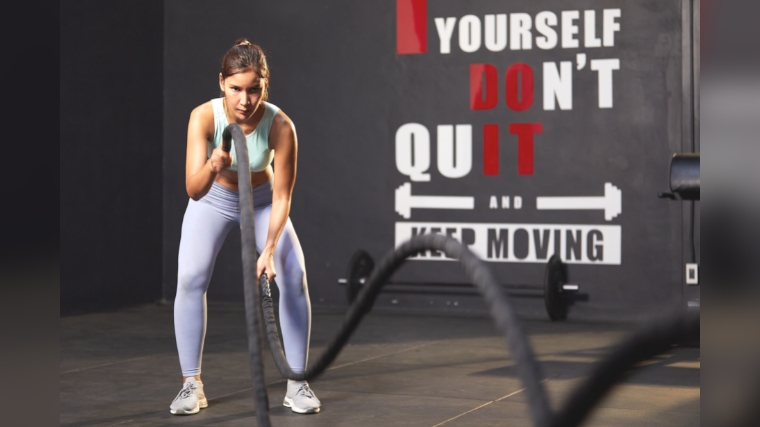
[Read More: The Best Bodyweight Exercises, + Workouts and Tips From a CPT]
You can also design CrossFit workouts entirely dedicated to speed and power training. This is how to optimize your results.
Assess Your Current Status
CrossFit goal-setting often involves taking stock of where you want to go. Then, take a realistic inventory of where you are now. Are you excellent at powering through box jumps but flounder when you’re asked to perform a round of 21-15-9 thrusters?
Jot down some notes to record both your goals and your starting point. It might be worth writing down some data from recent WODs. Include components of power training that you’re really good at and those where you want to improve.
Rank Your Priorities
If you’re reading this, you likely want to get faster and more powerful. But there are different ways to accomplish this.
For example, a sprinter is fast and has a ton of lower body power. That doesn’t necessarily mean that a sprinter can pull off a heavy clean & jerk. And while an experienced Olympic lifter likely has a ton of lower body power, they might not have the requisite skills to perform burpee box jumps.
As a CrossFitter, you’ll likely have to perform all of the above activities at some point. The goal is, after all, to be a well-rounded athlete. But that doesn’t mean you can’t have priorities in your training. Take a gander at your goals and your current abilities and form a ranked list of priorities.
For example, you might want to develop your power and speed with barbell work first and foremost. Upper body power might be your kryptonite, so you might decide to put that at a close second. In that case, your priorities might look like:
- Improve power and speed with Olympic lifts.
- Get faster and more efficient at muscle-ups and kipping pull-ups.
- Boost burpee box jump speed and power.
Many CrossFitters prefer to make their biggest shortcoming their top training priority. In the example above, one might just as easily choose to prioritize muscle-ups and kipping pull-ups over barbell work.
Whichever you choose, the list you make will inform the way you select your exercises and workout format.`
Choose Your Exercises
You can reliably expect to do a little bit of everything during any given week at your local CrossFit box. And while that can be helpful for a sense of accomplishment, community, and overall fitness, it may not be as effective at improving at specific goals.
To make sure you’re improving at specific touch points, you may have to be a little more intentional about scaffolding progressive overload into your training. If you want to prioritize a faster, more powerful upper body, it may not be as helpful to wait until the right WOD comes along every week or every other week.
When you’re designing your speed and power workouts, choose exercises that may not come up in every WOD — or even every week — that you need to improve. In the example above, you want to improve your Olympic lifts first and foremost. So, you might select moves like power cleans, snatches, and front squats to scatter into your workout.
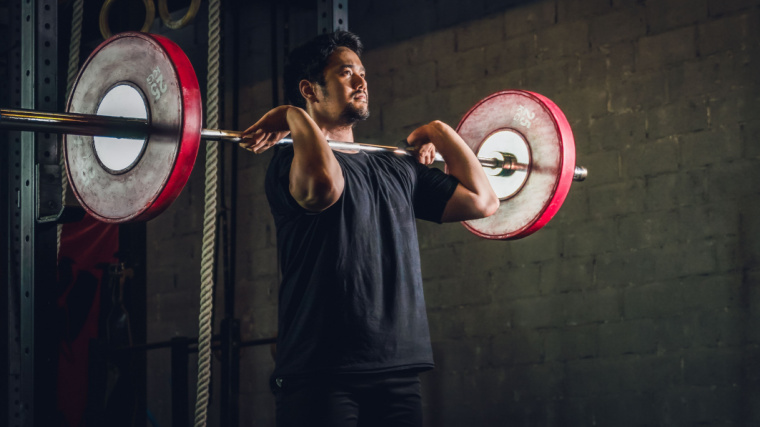
You’ll notice that these particular moves involve a lot of upper body stability and strength, but emphasize your lower body. That’s because your next priority for movements — your muscle-ups and kipping pull-ups — are upper-body focused.
Round your exercise list off with those burpee box jumps you’re looking to make faster and more powerful.
Select a Format
Once you have your exercises, it’s time to select your workout format. In CrossFit, the options run the gamut from long chippers and ladders to classic 21-15-9 workouts. Here’s a summary of some of these options:
- Chipper: You’ll do multiple exercises back-to-back, generally with a high number of reps. Perform all reps of each exercise before moving onto the next.
- Ladder: Organize your rep schemes like a ladder, descending from the first number. For example, start with 10 reps, then 9, then 8, etc.
- 21-15-9: Perform one or multiple exercises in a descending rep scheme: 21 reps, then 15 reps, then 9 reps.
- EMOM: Perform a set number of reps every minute, on the minute.
You can use this process to design multiple workouts — don’t feel the need to include every single movement in each WOD. That said, you can choose to integrate a wide variety of moves into a particularly nasty chipper.
However, truly maximizing your power output is something the body can only sustain for so long. If you’re looking for maximum power production in Olympic lifts, for example, you might not want to choose a long, grinding chipper. You’ll be certain to run out of energy, compromising your form and the entire point of generating the most force.
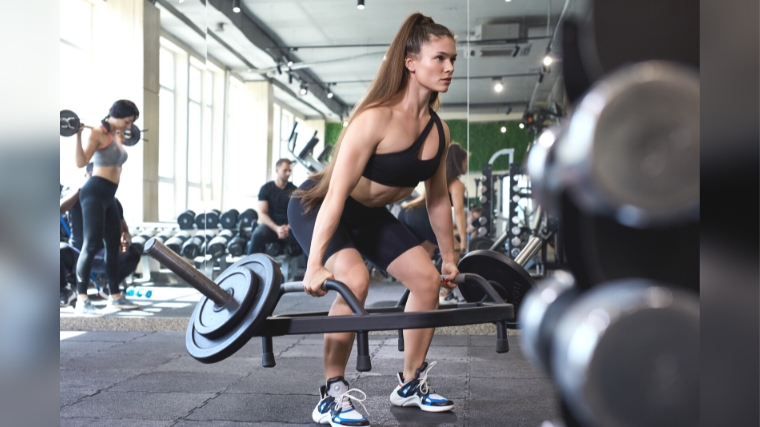
Still, if you choose your weights cleverly — i.e., use lighter weights — and organize your exercises to give different muscles groups active rest, you certainly can create a chipper if desired. Ultimately, this can help increase your work capacity. That’s a big plus for CrossFitters.
Note: Some athletes may want to select their format before choosing exercises. You can do this in whichever order makes the most sense to you. Just make sure that your exercises make sense with your format.
Record Your Results
Benchmark workouts are tremendous assets in CrossFit for a reason. Since so many workouts are performed for time, you’ll need to come back to the same workout a couple of times to take true note of your progress.
Select a couple of the speed and power workouts you design and be extra sure to record your results clearly. Take note of the weights you used, your rep scheme, and your final time. If relevant, also keep track of smaller things like box height and your time per round.
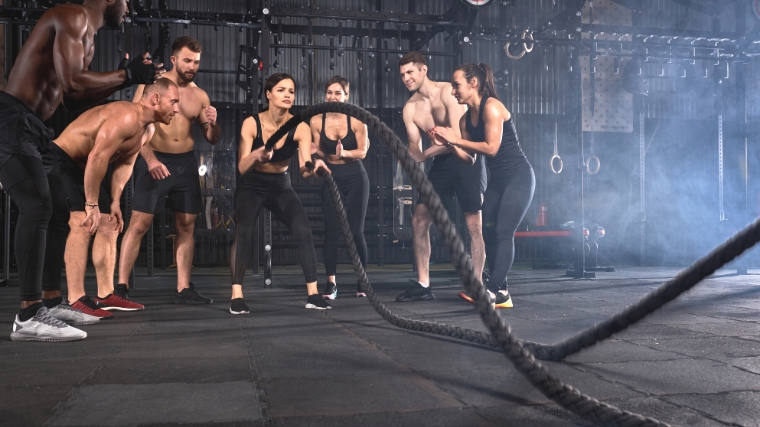
For athletes who are driven by qualitative data, you might also want to jot down less tangible information. For example: the time of day you worked out, how your body felt, how you slept the night before, and what you had for breakfast. All of these factors — as well as stress levels — can have a significant impact on your performance.
Come back to these results a month or two down the line to compare your performance. This is a helpful tool for tracking your progress. With this info, you can continue to overload your training responsibly and effectively.
Sample CrossFit Workout for Speed and Power
CrossFit workouts tend to be intentionally all over the place. They often involve many kinds of movements and modalities in each WOD. The sample workout here is like that. However, you can also pick it apart and perform the components that you most want to emphasize.
- 21 Power Cleans`
- 21 Muscle-Ups
- 21 Burpees
- 15 Power Cleans
- 15 Muscle-Ups
- 15 Burpees
- 9 Power Cleans
- 9 Muscle-Ups
- 9 Burpees
You can make modifications to this sample workout as desired to most accurately mirror your own goals, needs, and experience level. For example, swap out muscle-ups with jumping pull-ups. Perform your sets in smaller chunks if need be. Just be sure to keep track of your total reps.
Your Takeaways
When you’re seriously into CrossFit, it’s almost a no-brainer that you’re going to get faster and more powerful. That’s kind of the nature of the beast. But if you want to really emphasize speed and power, here are the key things to remember:
- Strength is how much weight you can lift; power is how much weight you can lift in a given amount of time; and speed is how fast you can move. They’re all connected, but not the same.
- You don’t always have to lift heavier to get more powerful. Sometimes, lightening the load can help you get used to lifting weights faster. Add weight gradually from there.
- Make sure you’re doing plenty of plyometric movements and Olympic lifting to maximize both speed and power with heavy loads.
- Pushing your body to move faster can help you become faster in the long run even if you don’t actually speed up immediately.
- If you want to improve more than one thing, rank your priorities and choose your exercises and format accordingly.
- Track your results to make sure you’re seeing your improvements and can continue to use progressive overload techniques effectively.
Get Stronger, Faster
If you’re going hard in CrossFit training, you’re bound to get faster and stronger — even if speed and power aren’t your emphasis. But when you’re really looking to emphasize those skills, learning how to design speed and power-focused CrossFit workouts is a real asset.
By targeting certain CrossFit workouts toward speed and power development, you’ll improve your overall fitness and prowess in the sport. These are skills that will cross over into all aspects of your athletic training. So don’t wait. Grab a barbell, a plyo box, or even just your own bodyweight, and get going.
References
- Harris, Glenn R.; Stone, Michael H.; O’Bryant, Harold S.; Proulx, Christopher M.; Johnson, Robert L. (2000) Short-Term Performance Effects of High Power, High Force, or Combined Weight-Training Methods, Journal of Strength and Conditioning Research, 14(1). 14-20.
- Baker, D., Nance, S., & Moore, M. (2001). The load that maximizes the average mechanical power output during jump squats in power-trained athletes. Journal of strength and conditioning research, 15(1), 92–97.
- Adams K., O’Shea P. J., O’Shea L. K. (1992) The Effect of Six Weeks of Squat, Plyometric, and Squat-Plyometric Training on Power Production. Journal of strength and conditioning research, 6(1).
- Tricoli, V., Lamas, L., Carnevale, R., & Ugrinowitsch, C. (2005). Short-term effects on lower-body functional power development: weightlifting vs. vertical jump training programs. Journal of strength and conditioning research, 19(2), 433–437.
- Behm, D. G., & Sale, D. G. (1993). Intended rather than actual movement velocity determines velocity-specific training response. Journal of applied physiology (Bethesda, Md. : 1985), 74(1), 359–368.
Featured Image: Mongkolchon Akesin / Shutterstock